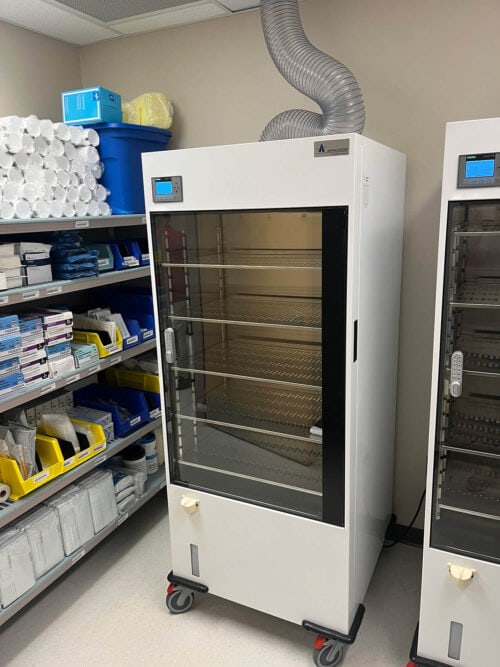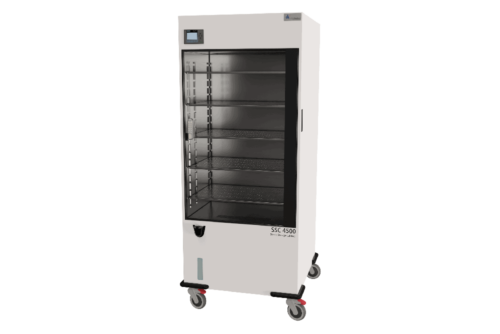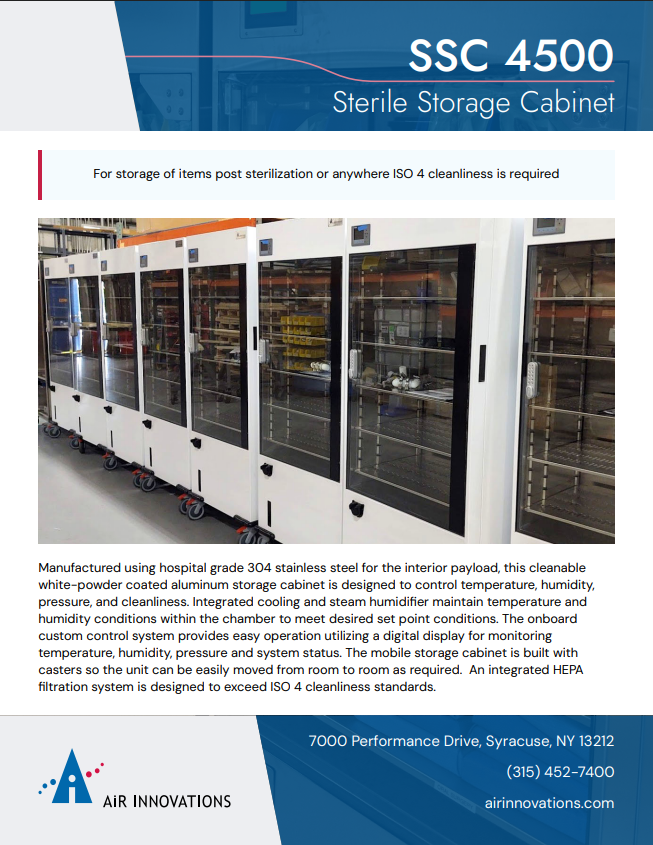Tag: Healthcare
Maintaining sterile storage conditions is necessary to protect medical instruments, drugs, surgical implants, and other equipment from contaminants. AORN guidelines on sterilization are straightforward: temperatures should not exceed 72℉ (22℃) to 78℉ (26℃), relative humidity should not exceed 60%, and airflow should be positive pressure with at least four total air changes per hour.
Hospital administrators and other end users should understand how sterile storage solutions have been designed to protect sensitive and often valuable medical supplies. This knowledge will enable them to select the best solution and know how to operate and maintain it for optimal performance.
How Sterile Storage Cabinets Preserve Sterility
Air Innovations has engineered a small modular sterile storage cabinet that can be deployed to hospital rooms, surgical facilities, or other medical facilities. Since the cabinet is much smaller than traditional autoclaves, it can be used in various locations. These sterile storage cabinets utilize multiple levels of functionality to ensure the equipment and sterilized packages are protected.
The first protective function is that all air in the cabinet recirculates through a HEPA filter at more than 250 air changes per hour—six times more than in a standard operating room. Any airborne viables in the cabinet are captured in the 99.97% efficient HEPA filter every 15 seconds. As an additional level of safety, an optional UV-C lamp can be installed above the HEPA filter to neutralize viruses or bacteria that may live on the filter.
Under most conditions, the sterile storage cabinet meets ISO4 cleanliness conditions. After opening the cabinet door, returning to this ultra-clean state takes less than five minutes.
The sterile storage cabinet’s second protective function is how it humidifies the cabinet space. The cabinet’s recommended use includes demineralized water, which has been treated to remove mineral impurities. The humidifier pulls water from the onboard storage tank and boils it to generate steam which is then injected into the storage cabinet. If bacteria or viruses were present in the water tank, they would be unable to live inside a boiling humidifier and could not reach the cabinet’s sterilized contents. The sterile storage cabinet’s humidifier has been programmed to boil until all the water is gone and the humidifier is dry after each . This allows users to store sterile items at the correct humidity without the risk of contamination from the water source.
Lastly, the cabinet is positively pressurized to prevent particles from infiltrating the space when the door is not open.
Sterile Storage Cabinets vs Cleanrooms
Sterile storage cabinets offer several primary benefits over cleanrooms.
First, the modular design of the cabinets enables hospital staff to decentralize their sterile storage to be closer to points of use. Cabinets are also more affordable than cleanrooms, which means hospitals can utilize more than one at a time. If a cabinet malfunctions, only the product stored in it is at risk, whereas if a cleanroom goes down, all the product within that space may be lost or need to be sterilized again. A backup sterile storage cabinet can be deployed quickly and easily in the same area. Lastly, people carry the greatest risk in a sterile environment. Hospital staff frequently access cleanrooms, where cabinets inherently isolate sensitive medical devices and products away from people.
By storing valuable medical supplies in cabinets designed to meet rigorous air purification standards and use humidity and positive pressure to ensure sterility, hospital administrators and staff will have peace of mind to focus on what they have been trained to do: treat patients and save lives. Download the sterile storage cabinet datasheet to learn more.
Note: The SSC4500 is not intended for use in the diagnosis of disease or other conditions or in the cure, mitigation, treatment, or prevention, of disease in humans or in other animals.

 Sterile Storage Cabinet In A Hospital
Sterile Storage Cabinet In A Hospital

